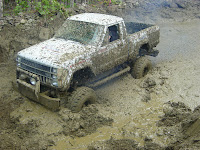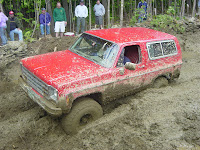
The trucks ranged from mild street drivers to highly modified rigs built just for the mud. The pit was about 100 feet long, and early in the day, it was perfect for training and smaller tired trucks.



This Toyota had 38's or 40's and performed well, but when the mud got deeper, he was hindered by a stock motor.

After watching everyone make it through with relative ease, it was time to toughen up the pit a little. With the help of a backhoe, bog revision was done in no time, and the drivers were more than ready to go.

____________________________________________________________________
Some of the big boys went through first to mix up the mud. Stage two of the bog was definitely more of a challenge, but nearly everyone was still able to make it through.


This guy said "You wont break this box tubing bumper.", and he was right, too bad he couldn't say the same for the bumper brackets. Later that day, the rear bumper suffered a similar plight.
____________________________________________________________________


This jeep was an awesome performer, and a real crowd pleaser.
_____________________________________________________________________________________



This Nissan, to me, gets right to the heart of what this sport is all about. Build a truck you can afford, modify to the best of your abilities or wallet, and hit the pit. When someone who has a bogger like this, and beats it mercilessly to get through the pit, the cheers from the crowd are as loud as for the bigger trucks. Everybody loves an underdog.
_____________________________________________________________________________________
As the pit gets meaner, you have to try to pick a different line, especially if you have smaller tires or less power.


This Cherokee looked like a good performer, but the driver pussy footed at the beginning of the pit and didn't have the momentum to get through, so he got pulled out too.
_____________________________________________________________________________________

This Chevy has 2 1/2 ton axles and a custom lift. A modified 454 pushes it along, and it did perform.

This guy tried hard, and we all cheered hard for him, but it wasn't to be. When he got pulled out, his bumper folded up and put his brush guard through his radiator. A good lesson though.
_____________________________________________________________________________________



The bog shows no favorites. This cruiser belongs to the host and land owner. It has full size truck axles and a modified Chevy small block.
_____________________________________________________________________________________

It now seemed like the right thing to do would be to massage the pit again, so out came the backhoe, and things started to get interesting after this.
_____________________________________________________________________________________

This girl in the green jeep did great all day long. She got stuck right after this picture was taken, and she claimed it was only the second time she had ever been stuck.
_____________________________________________________________________________________

This truck is full of young girls no doubt driving dad's truck. It got really stuck. I hope her dad doesn't see this!
____________________________________________________________________________________

This Toyota has 38 inch gumbo mudders and the motor has been beefed up. I have seen him pound this truck senseless for at least five years, but here it finally spun a bearing.

I know I'm a self professed ford man, but this truck is the only one that actually shook the ground under my feet, and he only has $500 into the build. I will be doing a feature post on this truck coming soon.

This Suzuki had amazing traction and would have been a great performer, but it just ran out of power and would not even turn the tires.
____________________________________________________________________________________

Perfect weather, good people, and medbogging, what could be better. The only thing missing was our truck, which sits pathetically in the grass, just waiting for me to find the time to finish it. Maybe next time. Happy mudding.


















